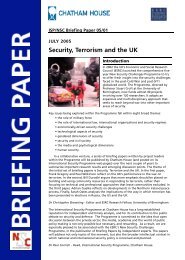Bill Durodié Fear and Terror in a Post-Political Age - Bill Durodie
Bill Durodié Fear and Terror in a Post-Political Age - Bill Durodie
Bill Durodié Fear and Terror in a Post-Political Age - Bill Durodie
Create successful ePaper yourself
Turn your PDF publications into a flip-book with our unique Google optimized e-Paper software.
FEAR AND TERROR IN A POST-POLITICAL AGE447resolved by tra<strong>in</strong><strong>in</strong>g ourselves to respond technically to disasters, butby a much broader level of debate <strong>and</strong> engagement <strong>in</strong> society, notjust <strong>in</strong> relation to terrorism <strong>and</strong> other crises, but to broader socialissues. Presumably, people are prepared to risk their lives fight<strong>in</strong>gfires or fight<strong>in</strong>g wars, not so that their children can, <strong>in</strong> their turn,grow up to fight fires <strong>and</strong> fight wars, but because they believe thatthere is someth<strong>in</strong>g more important to life worth fight<strong>in</strong>g for. It is theabsence of any discussion as to what that someth<strong>in</strong>g more importantis that leaves us effectively unarmed <strong>in</strong> the face of adversity today.SOCIAL RESILIENCEIn September 1940, at the height of the Blitz, 5,730 people lost theirlives <strong>in</strong> London alone. This is one hundred times larger than thenumber killed by the London bombers on 7 July 2005. By the end ofthe Second World War the f<strong>in</strong>al fatality count <strong>in</strong> London had reached30,000. How could the British population be so resilient <strong>in</strong> the face ofsuch adversity? In his l<strong>and</strong>mark study, represent<strong>in</strong>g the official <strong>in</strong>terpretationof these events, Richard Titmuss suggested the key factorsto have been clear leadership, equitable treatment <strong>and</strong> the provisionof full employment to keep people occupied. 65 Others, such as AngusCalder, have questioned this <strong>in</strong>terpretation, po<strong>in</strong>t<strong>in</strong>g to the existenceof loot<strong>in</strong>g, a significant black market <strong>and</strong> juvenile del<strong>in</strong>quency asevidence that the famed ‘Blitz spirit’ was not all that it was cracked upto be. 66 Nevertheless, it is clear that the overall response was a remarkabledisplay of fortitude. And whilst government motives may havebeen brought <strong>in</strong>to question, at the time <strong>and</strong> subsequently, at least itis reasonably clear that it had some motives. Dur<strong>in</strong>g the SecondWorld War, there was a clear sense of the need to carry on withnormal life <strong>and</strong> to ma<strong>in</strong>ta<strong>in</strong> everyday roles <strong>and</strong> responsibilities. Mostof the population was actively engaged <strong>in</strong> the war effort <strong>and</strong> there wasa particular focus on ensur<strong>in</strong>g that people would not develop a‘shelter mentality’. 6765 R. M. Titmuss, Problems of Social Policy, Nott<strong>in</strong>gham, HMSO, 1950.66 A. Calder, The Myth of the Blitz, London, Jonathan Cape, 1991.67 E. Jones, R. Woolven, B. Durodié <strong>and</strong> S. Wessely, ‘Civilian Morale Dur<strong>in</strong>g theSecond World: Responses to Air Raids Re-Exam<strong>in</strong>ed’, Social History of Medic<strong>in</strong>e, 17:3(2004), pp. 463–79.© The Author 2007. Journal compilation © 2007 Government <strong>and</strong> Opposition Ltd



